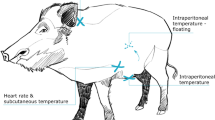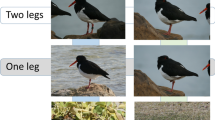Abstract
This report describes thermoregulatory behavior of free-ranging yellow baboons (Papio cynocephalus) in Amboseli, Kenya. While resting in trees during early morning hours, baboons are directly exposed to thermal effects of wind and sun. We hypothesized that these animals would respond to microclimatic changes by altering their posture and body orientatio so as to minimize thermal stress. The results of this study indicate that air temperature, solar radiation, and wind velocity interact in their effect on behavior as predicted by this hypothesis. Specifically, the most salient cue for trunk orientation choice is wind direction, while posture is primarily influenced by air temperature. In sum, our results clearly demonstrate that when baboons are unable to minimize thermal stress by selecting a more favorable microenvironment, they do so by altering their posture.
Similar content being viewed by others
References
Adair, E. R., 1976. Autonomic thermoregulation in squirrel monkey when behavioral regulation is limited.J. Appl. Physiol., 40: 694–700.
————, 1977. Skin, preoptic, and core temperature influence behavioral thermoregulation.J. Appl. Physiol., 42: 559–564.
———— &J. T. Stitt, 1971. Behavioral temperature regulation in the squirrel monkey: effects of midbrain temperature displacements.J. Physiol. (Paris), 63: 191–194.
———— &B. A. Wright, 1976. Behavioral temperature regulation in the squirrel monkey when response effort is varied.J. Comp. Physiol. Psychol., 90: 179–184.
Altmann, J., 1974. Observational study of behavior: sampling methods.Behaviour, 49: 227–267.
Altmann, S. A. &J. Altmann, 1970.Baboon Ecology: African Field Research. S. Karger, Basel.
Anderson, J. R. &W. C. McGrew, 1984. Guinea baboons (Papio papio) at a sleeping site.Amer. J. Primatol., 6: 1–14.
Bakken, G. S., 1976. A heat transfer analysis of animals: unifying concepts and the application of metabolism chamber data to field ecology.J. Theor. Biol., 60: 337–384.
————, 1981. A two-dimensional operative-temperature model for thermal energy management by animals.J. Therm. Biol., 6: 23–30.
Bernstein, I., 1972. Daily activity cycles and weather influences on a pigtailed monkey group.Folia Primatol., 18: 390–415.
Bruns, E. H., 1977. Winter behavior of pronghorns in relation to habitat.J. Wildl. Manag., 41: 560–571.
Cena, K. &J. A. Clark, 1973. Thermal radiation from animal coats: coat structure and measurements of radiative temperature.Phys. Med. Biol., 18: 432–443.
Dahl, J. F., I. S. Bernstein, &L. Williams, 1982. Thermoregulation and social structure of a captive group of rhesus macaques.Int. J. Primatol., 3: 273.
———— &E. O. Smith, 1985. Assessing variation in the social behavior of stumptail macaques using thermal criteria.Amer. J. Phys. Anthropol., 68: 467–477.
Gale, C. C., M. Matthews, &J. Young, 1970. Behavioral thermoregulatory responses to hypothalamic cooling and warming in baboons.Physiol. Behav., 5: 1–6.
Gates, D. M., 1980.Biophysical Ecology. Springer-Verlag, New York.
Hausfater, G. &B. J. Meade, 1982. Alternation of sleeping groves by yellow baboons (Papio cynocephalus) as a strategy for parasite avoidance.Primates, 23: 287–297.
Huey, R. B. &E. R. Pianka, 1977. Seasonal variation in thermoregulatory behavior and body temperature of diurnal Kalahari lizards.Ecology, 58: 1066–1075.
———— &M. Slatkin, 1976. Cost and benefits of lizard thermoregulation.Quart. Rev. Biol., 51: 363–384.
Ingram, D. L. &K. F. Legge, 1970. The thermoregulatory behavior of young pigs in a natural environment.Physiol. Behav., 5: 981–987.
Kerslake, D. M., 1972.The Stress of Hot Environments. Cambridge Univ. Press, Cambridge.
Lustick, S., B. Battersby, &M. Kelty, 1978. Behavioral thermoregulation: orientation to the sun in herring gulls.Science, 200: 81–83.
Moen, A. N., 1973.Wildlife Ecology, an Analytical Approach. W. H. Freeman, San Francisco.
Muth, A., 1977. Thermoregulatory postures and orientation to the sun: a mechanistic evaluation for the zebra-tailed lizardCallisaurus draconoides.Copeia, 1977: 710–720.
Norris, K. S., 1967. Color adaptation in desert reptiles and its thermal relationships. In:Lizard Ecology, a Symposium,W. W. Milstead (ed.), Univ. of Missouri Press, Columbia, MO, pp. 162–229.
Øritsland, N. A. &K. Ronald, 1978. Solar heating of mammals: observations of hair transmittance.Int. J. Biometeorol., 22: 197–201.
Patterson, J. D., 1986. Shape as a factor in primate thermoregulation. In:Proceedings of the IXth Congress of the International Primatological Society. Vol. 1: Current Perspectives in Primate Social Dynamics,D. M. Taub &F. A. King (eds.), Van Nostrand Reinhold, New York, pp. 228–242.
Porter, W. P. &D. M. Gates, 1969. Thermodynamic equilibria of animals with environment.Ecol. Monogr., 39: 227–244.
———— &F. C. James, 1979. Behavioral implications of mechanistic ecology II: the African rainbow lizard,Agama agama. Copeia, 1979: 594–619.
———— &C. R. Tracy, 1980. Biophysical analyses of energetics, time-space utilization, and distributional limits of lizards. In:Lizard Ecology Symposium,R. Huey,T. Schoener, &E. Pianka (eds.), Harvard Univ. Press, Cambridge, MA.
Post, D., 1978. Feeding and ranging behavior of the yellow baboon (Papio cynocephalus). Unpubl. doctoral dissertation. Yale Univ., New Haven, Connecticut.
————,G. Hausfater, &S. A. McCuskey, 1980. Feeding behavior of yellow baboons (Papio cynocephalus): relationship to age, gender, and dominance rank.Folia Primatol., 34: 170–195.
Roughgarden, J., W. P. Porter, &D. Heckel, 1981. Resource partitioning of space and its relationship to body temperature inAnolis lizard populations.Oecologia (Berlin), 50: 256–264.
Sale, J. B., 1970. The behavior of the resting rock hyrax in relation to its environment.Zool. Afr., 5: 87–99.
Satinoff, E., 1978. Neural organization and evolution of thermal regulation in mammals.Science, 201: 16–22.
Sharman, M., 1980. Feeding, ranging, and social organization of the Guinea baboon (Papio papio) in Senegal. Unpubl. doctoral dissertation, Univ. of St. Andrews, Scotland.
Slatkin, M. &G. Hausfater, 1976. A note on the activity of a solitary male baboon.Primates, 17: 311–322.
Snedecor, G. W. &W. G. Cochran, 1980.Statistical Methods. Iowa State Univ. Press, Ames, Iowa.
Stevenson, R. D., 1985. The relative importance of behavioral and physiological adjustments controlling body temperature in terrestrial ectotherms.Amer. Naturalist, 126: 362–386.
Stolz, L. P. &G. S. Saymann, 1970. Ecology and behavior of baboons in the Northern Transvaal.Ann. Transvaal Mus., 26: 99–143.
Treager, R. T., 1965. Hair density, wind speed, and heat loss in mammals.J. Appl. Physiol., 20: 796–801.
Velleman, P. F. &D. C. Hoaglin, 1981.Applications, Basics, and Computing of Exploratory Data Analysis. Duxbury Press, Boston.
Waldschmidt, S., 1980. Orientation to the sun by the iguanid lizardsUta stansburiana andSceloporus undulatus: hourly and monthly variations.Copeia, 1980: 458–462.
Walsberg, G. E., G. S. Campbell, &J. R. King, 1978. Animal coat color and radiative gain: a reevaluation.J. Comp. Physiol., 126B: 211–222.
Author information
Authors and Affiliations
About this article
Cite this article
Stelzner, J.K., Hausfater, G. Posture, microclimate, and thermoregulation in yellow baboons. Primates 27, 449–463 (1986). https://doi.org/10.1007/BF02381890
Received:
Accepted:
Issue Date:
DOI: https://doi.org/10.1007/BF02381890




